Assessment of an External Cooling System Using Experimental Methods for Thrust Bearing in a Large Hydraulic Unit
Abstract
:1. Introduction
- Investigation of the effect of changes in oil and water flow rates of the new TBCS with PTHEs on the bearing pad temperatures.
- Investigation of the effect of replacing old type STHEs with modern technology PTHEs on cooling performance of TBCS.
- Comparison of operating performances of existing STHEs and new PTHEs.
- Determining the optimum operating condition and evaluating the system performance by operating new PTHEs under different conditions with a modern automation system.
2. Materials and Methods
2.1. External Thrust Bearing Cooling System Design
2.2. Digitalization of Thrust Bearing and Cooling Systems
3. Results and Discussion
- Amount of oil cooling rates;
- Average cooling rate;
- Oil temperature difference;
- APT.
- Average cooling rate;
- Oil inlet–outlet temperature and oil temperature difference;
- APT;
- Generator winding temperature.
3.1. First Stage of the Tests
3.2. Second Stage of the Tests
- At 1110, 1195, and 1411 L/min oil flow rate, APT is 75.4 °C to 75.2 °C and 74.6 °C, respectively.
- When the oil circulation flow rate was increased from 1110 to 1195 (7.7% increase) and 1411 L/min (21% increase), the APT decreased by 0.2 °C (0.27% decrease) and 0.8 °C (1.1% decrease), respectively.
- Oil inlet temperature of the bearing is almost unchanged at ~25.8 °C because of high efficiency of PTHE and increasing heat transfer coefficient by increasing oil flow rate, causing the oil temperature at the exchanger outlet to be similar.
- At 1110, 1195, and 1411 L/min oil flow rate, the oil outlet temperature is 33.8 °C, 32.9 °C, and 32.1 °C, respectively. This situation shows that the PTHEs used in the new TBCS can provide sufficient cooling even when the water flow rate decreases and the increase in the oil circulation flow rate is effective in reducing the APT and the temperature of the oil leaving the bearing.
- The unit increase in oil circulation flow rate causes a decrease of approximately 0.0025 °C in the APT.
- When the water circulation flow rate was reduced from 608 to 580 L/min, the APT increased from 75.3 to 75.4 (0.2 °C and 0.27%).
- The unit decrease in the cooling water flow rate caused an increase of approximately 0.007 °C in the APT.
- Since the unit decrease in water flow rate increased the APT by approximately 0.007 °C, an increase of approximately 0.57 °C occurred in the APT in addition to the increase caused by the decrease in water flow rate.
- The APT also increases with the increase in unit power and this increase is approximately 0.008 °C per megawatt.
- APT underwent an incremental rise from 74.8 °C (at 145.9 MW) to 74.9 °C (at 146.1 MW) and 75.2 °C (at 150.1 MW). Concurrently, the maximum winding temperature ascended to 95.3 °C, 95.7 °C, and 99.6 °C, respectively.
- Despite the decrease in water flow rate (40 and 52 L/min) to the new TBCS with PTHE and the unit power’s approximate 4 MW augmentation, no substantial increase in APTs was noted (0.4 °C increase).
- The increase in unit power also increases the winding temperatures. Each megawatt increase in unit power increases the maximum winding temperature by approximately 1.1 °C.
3.3. Third Stage of the Tests
- The cooling rate in the old and new systems is approximately the same;
- Approximately twice as much cooling water is used to provide the same amount of cooling as the old TBCS with STHEs;
- The APT is 1.7 °C higher, the oil temperature difference is 1 °C and the average winding temperature is 1.3 °C higher when the old TBCS is used;
- The temperature of the oil entering and leaving the old cooling system is approximately 4 °C higher than in the new system;
- The oil temperature difference in the old cooling system is approximately 1 °C higher than in the new system;
- The PTHEs used in the new system have much higher performance than the STHEs in the old system;
- Thanks to the low water consumption in the new system, more cooling water is supplied to the generator winding cooling system and the maximum winding temperature is 1.3 °C lower.
3.4. Error Analysis
4. Conclusions
Author Contributions
Funding
Data Availability Statement
Acknowledgments
Conflicts of Interest
Abbreviations
| TBCS | thrust bearing cooling system |
| GW | Gigawatts |
| STHEs | Shell-and-tube heat exchangers |
| PTHEs | Plate-type heat exchangers |
| APT | Average pad temperature |
References
- Zhao, Y.; Yang, C.; Shi, G.; Xu, Y.; Mei, X.; Yan, D.; Lowell, Z. From order to reorder: Assessment of the living environment of hydropower resettlement for just energy transition in China. Energy Rep. 2024, 11, 5668–5681. [Google Scholar] [CrossRef]
- Yu, P.S.; Yang, T.C.; Kuo, C.M.; Chou, J.C.; Tseng, H.W. Climate change impacts on reservoir inflows and subsequent hydroelectric power generation for cascaded hydropower plants. Hydrol. Sci. J. 2014, 59, 1196–1212. [Google Scholar] [CrossRef]
- Aryal, S.; Ghimire, S.; Tiwari, S.; Baaniya, Y.; Pandey, V.P. Evolution and future prospects of hydropower sector in Nepal: A review. Heliyon 2024, 10, e31139. [Google Scholar] [CrossRef] [PubMed]
- Liu, B.; Yang, Z.; Chen, Y.; Li, L.; Chen, S. A decision-making framework for scheme selection for sustainable hydropower development. Int. J. Green Energy 2021, 18, 951–965. [Google Scholar] [CrossRef]
- Kazantsev, Y.; Kornilovich, D.V.D.V.; Khalyasmaa, A.I.; Arhipov, A.A.; Miklukhin, A.V.; Sergievichev, L.Y.; Tsuran, M.V. Novel technologies for optimization of hydroelectric power plants with hydrogen energy storage system. Int. J. Hydrogen Energy 2024, 96, 952–961. [Google Scholar] [CrossRef]
- Pereira da Silva, P.; Horta, P. The effect of variable renewable energy sources on electricity price volatility: The case of the Iberian market. Int. J. Sustain. Energy 2019, 38, 794–813. [Google Scholar] [CrossRef]
- He, M.; Han, S.; Chen, D.; Zhao, Z.; Jurasz, J.; Mahmud, M.A.; Deng, M. Optimizing Cascade Hydropower-VRE Hybrid Systems: A Novel Approach Addressing Whole-Process Vibration to Enhance Operational Safety. Energy 2024, 304, 131965. [Google Scholar] [CrossRef]
- Salkuti, S.R. Multi-objective-based optimal transmission switching and demand response for managing congestion in hybrid power systems. Int. J. Green Energy 2020, 17, 457–466. [Google Scholar] [CrossRef]
- Aljafari, B.; Pamshetti, V.B.; Thanikanti, S.B. Maximizing techno-economic-environmental benefits of renewable energy allocation with smart inverter in distribution system: A two-layer stochastic optimization framework. Int. J. Green Energy 2023, 1–18. [Google Scholar] [CrossRef]
- Cheng, Q.; Liu, P.; Feng, M.; Cheng, L.; Ming, B.; Luo, X.; Xia, J. Complementary operation with wind and photovoltaic power induces the decrease in hydropower efficiency. Appl. Energy 2023, 339, 121006. [Google Scholar] [CrossRef]
- Fillon, M.; Wodtke, M.; Wasilczuk, M. Effect of presence of lifting pocket on the THD performance of a large tilting-pad thrust bearing. Friction 2015, 3, 266–274. [Google Scholar] [CrossRef]
- Pajączkowski, P.; Schubert, A.; Wasilczuk, M.; Wodtke, M. Simulation of large thrust-bearing performance at transient states, warm and cold start-up. Proc. Inst. Mech. Eng. Part J J. Eng. Tribol. 2014, 228, 96–103. [Google Scholar] [CrossRef]
- Ji, Z.; Shi, Y.; Da, X.; Cao, J.; Gong, Q.; Wang, Z.; Huang, X. Influence of installation deviation of thrust bearing on oil film flow of 1000 MW hydraulic turbine unit. Water 2023, 15, 1649. [Google Scholar] [CrossRef]
- Wodtke, M.; Schubert, A.; Fillon, M.; Wasilczuk, M.; Pajączkowski, P. Large hydrodynamic thrust bearing: Comparison of the calculations and measurements. Proceedings of the Institution of Mechanical Engineers. Part J J. Eng. Tribol. 2014, 228, 974–983. [Google Scholar] [CrossRef]
- Sedlář, M.; Abrahámek, P. Numerical Analysis of Oil Lubrication and Cooling of Roller Thrust Bearing in High-Performance Mixed-Flow Pump. Energies 2023, 16, 6890. [Google Scholar] [CrossRef]
- Dąbrowski, L.; Wasilczuk, M. Evaluation of water turbine hydrodynamic thrust bearing performance on the basis of thermoelastohydrodynamic calculations and operational data. Proc. Inst. Mech. Eng. Part J J. Eng. Tribol. 2004, 218, 413–421. [Google Scholar] [CrossRef]
- Kingsbury, I. A General Guide to the Principles, Operation and Troubleshooting of: Hydrodynamic Bearings; Publication HB: Philadelphia, PA, USA, 2016; p. 10. [Google Scholar]
- Liu, H.; Yu, Q.; Tan, Y.; Xu, W.; Huang, B.; Xie, Z.; Mao, J. Feasibility study on temperature distribution measurement method of thrust sliding bearing bush based on FBG quasi-distributed sensing. Sensors 2019, 19, 3245. [Google Scholar] [CrossRef] [PubMed]
- Wasilczuk, M. Friction and lubrication of large tilting-pad thrust bearings. Lubricants 2015, 3, 164–180. [Google Scholar] [CrossRef]
- Liming, Z.; Yongyao, L.; Zhengwei, W.; Xin, L.; Yexiang, X. A review on the large tilting pad thrust bearings in the hydropower units. Renew. Sustain. Energy Rev. 2017, 69, 1182–1198. [Google Scholar] [CrossRef]
- Glavatskih, S.B.; Fillon, M. TEHD analysis of thrust bearings with PTFE-faced pads. J. Tribol. 2006, 128, 49–58. [Google Scholar] [CrossRef]
- Zhou, J.; Blair, B.; Argires, J.; Pitsch, D. Experimental performance study of a high speed oil lubricated polymer thrust bearing. Lubricants 2015, 3, 3–13. [Google Scholar] [CrossRef]
- Mottershead, G.; Bomben, S.; Kerszenbaum, I.; Klempner, G. Handbook of Large Hydro Generators: Operation and Maintenance; John Wiley & Sons: Hoboken, NJ, USA, 2020; p. 76. [Google Scholar]
- Bahiraei, M.; Naseri, M.; Monavari, A. A second law analysis on flow of a nanofluid in a shell-and-tube heat exchanger equipped with new unilateral ladder type helical baffles. Powder Technol. 2021, 394, 234–249. [Google Scholar] [CrossRef]
- Panday, N.K.; Singh, S.N. Study of thermo-hydraulic performance of chevron type plate heat exchanger with wire inserts in the channel. Int. J. Therm. Sci. 2022, 173, 107360. [Google Scholar] [CrossRef]
- Mohammadi, K.; Heidemann, W.; Müller-Steinhagen, H. Numerical investigation of the effect of baffle orientation on heat transfer and pressure drop in a shell and tube heat exchanger with leakage flows. Heat Transf. Eng. 2009, 30, 1123–1135. [Google Scholar] [CrossRef]
- Wang, Q.; Chen, G.; Chen, Q.; Zeng, M. Review of Improvements on Shell-and-Tube Heat Exchangers with Helical Baffles. Heat Transf. Eng. 2010, 31, 836–853. [Google Scholar] [CrossRef]
- Lin, W.; Zhang, W.; Ling, Z.; Fang, X.; Zhang, Z. Experimental study of the thermal performance of a novel plate type heat exchanger with phase change material. Appl. Therm. Eng. 2020, 178, 115630. [Google Scholar] [CrossRef]
- Jegla, Z.; Stehlik, P.; Kohoutek, J. Alternative approach in optimization of plate type heat exchangers. Heat Transf. Eng. 2004, 25, 6–15. [Google Scholar] [CrossRef]
- Hamedi, H.; Setayeshfar, B.; Sadat, M.; Farshidianfar, A.; Mahvan, A.; Asadi, M. Experimental and numerical analysis of the thermo-hydraulic performance of a cross-flow air-to-gas capsule-type plate heat exchanger. Appl. Therm. Eng. 2024, 236, 121900. [Google Scholar] [CrossRef]
- Dąbrowski, L.; Wasilczuk, M.; Lewandowski, S. Field tests of a thrust bearing of a pump-turbine—Analysis of the time of hydrostatic pump operation on bearing properties—In Polish. Tribologia. 2002, 181, 185–200. [Google Scholar]
- Najar, F.A.; Harmain, G.A. Novel approach towards thrust bearing pad cooling. In Gas Turbine India Conference; American Society of Mechanical Engineers: New Delhi, India, 2014; Volume 49644, p. V001T06A004. [Google Scholar]
- Najar, F.A.; Harmain, G.A. Thermal effects for conventional and water-cooled thrust bearing using finite difference method: Comparative analysis. Int. J. Precis. Technol. 2015, 5, 14–26. [Google Scholar] [CrossRef]
- Bhat, J.A.; Harmain, G.A.; Najar, F.A. Alleviating thermal challenges in hydrodynamic bearings: A novel approach through thrust bearing pads with embedded cooling circuitry and deep recess. Tribol. Int. 2024, 194, 109438. [Google Scholar] [CrossRef]
- Cengel, Y.A.; Afshin, J.G. Heat and Mass Transfer: Fundamentals and Applications, 6th ed.; Chapter 1 Introduction and Basics Concepts; McGraw-Hill Education: New York, NY, USA, 2020. [Google Scholar]
- Jamali, R.; Sohani, A.; Hemmatpour, K.; Behrang, M.; Ghobeity, A. Experimental study of pressure pulsation in a large-scale hydropower plant with Francis turbine units and a common penstock. Energy Convers. Manag. X 2022, 16, 100308. [Google Scholar] [CrossRef]
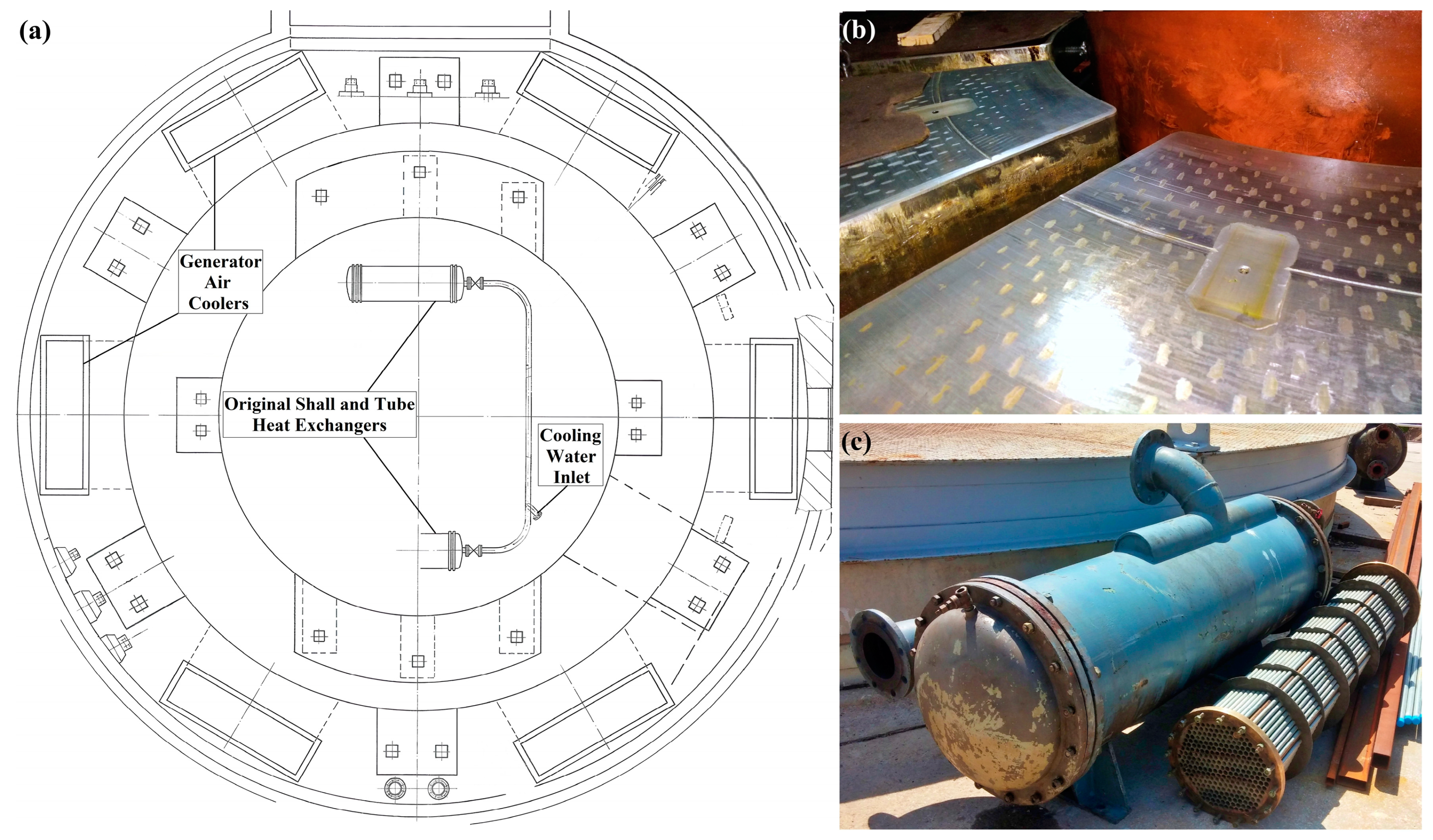

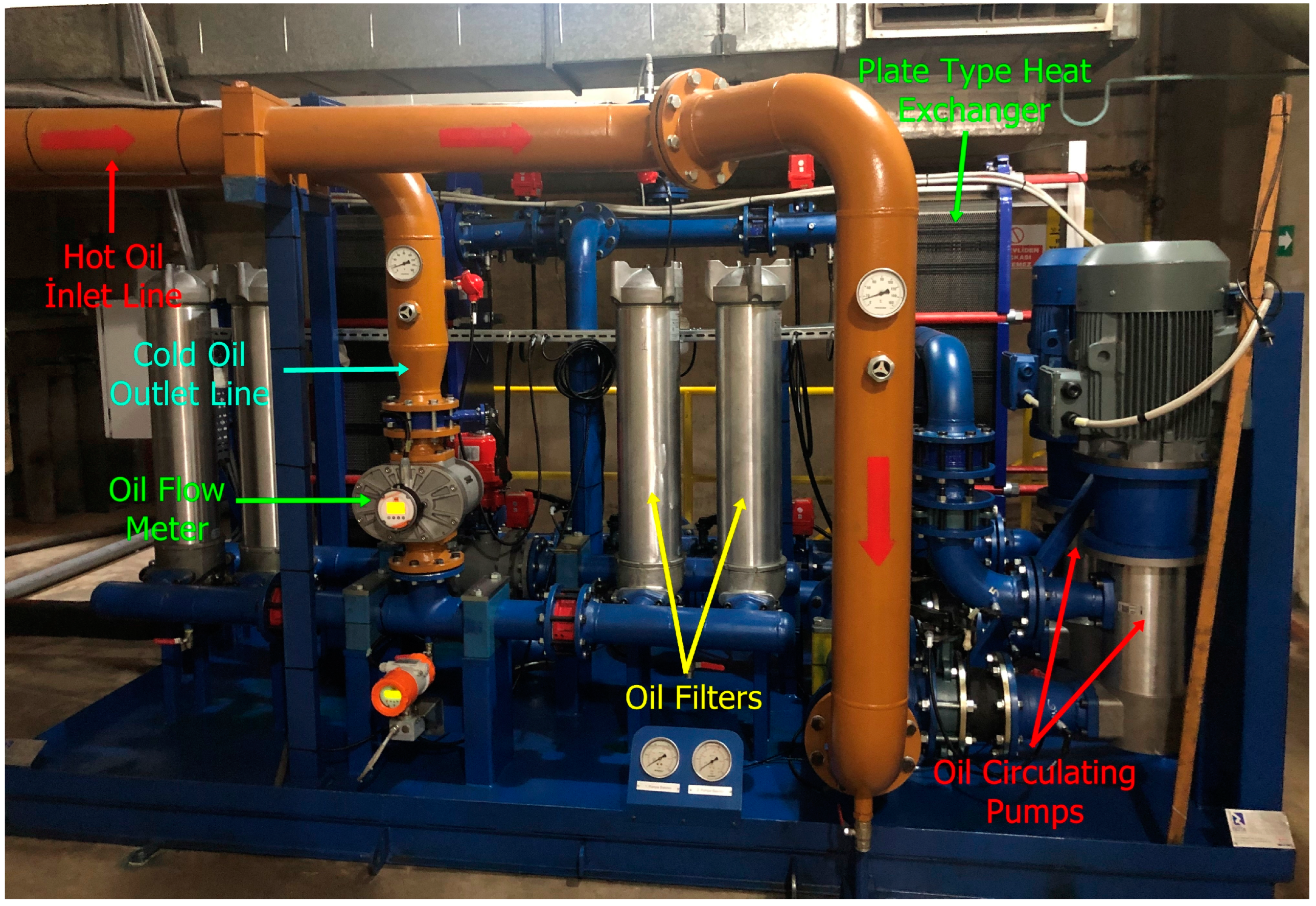

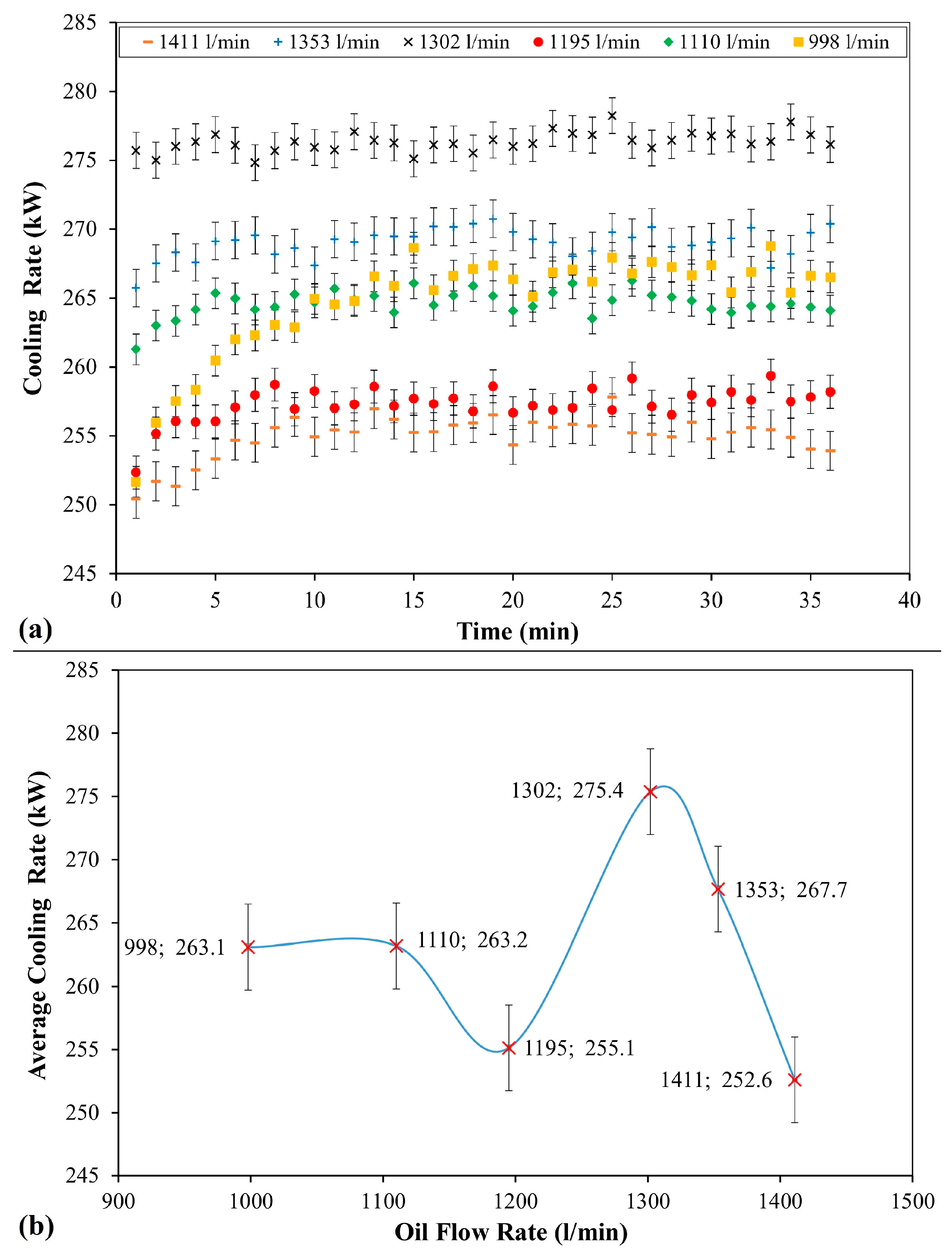
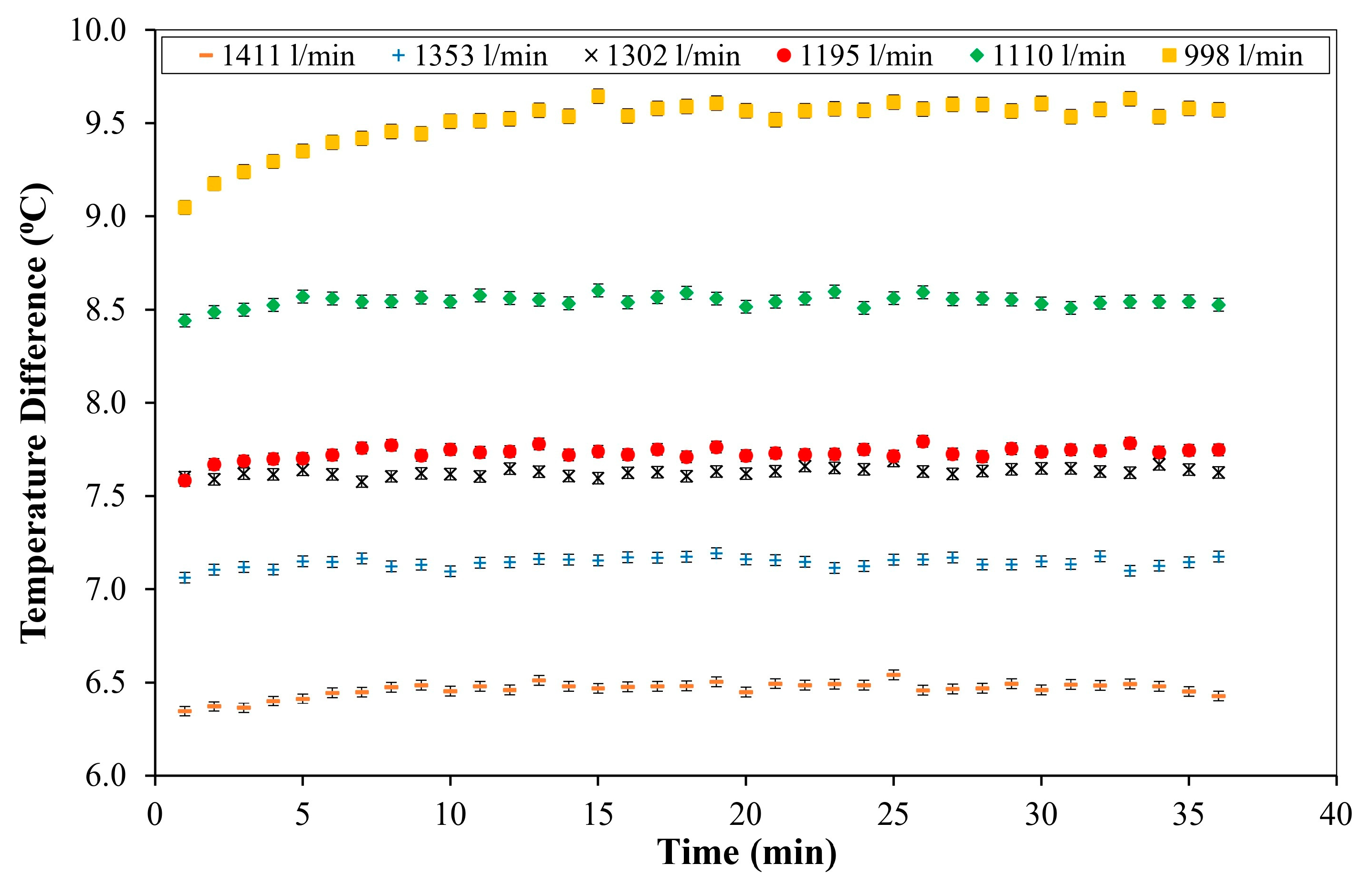
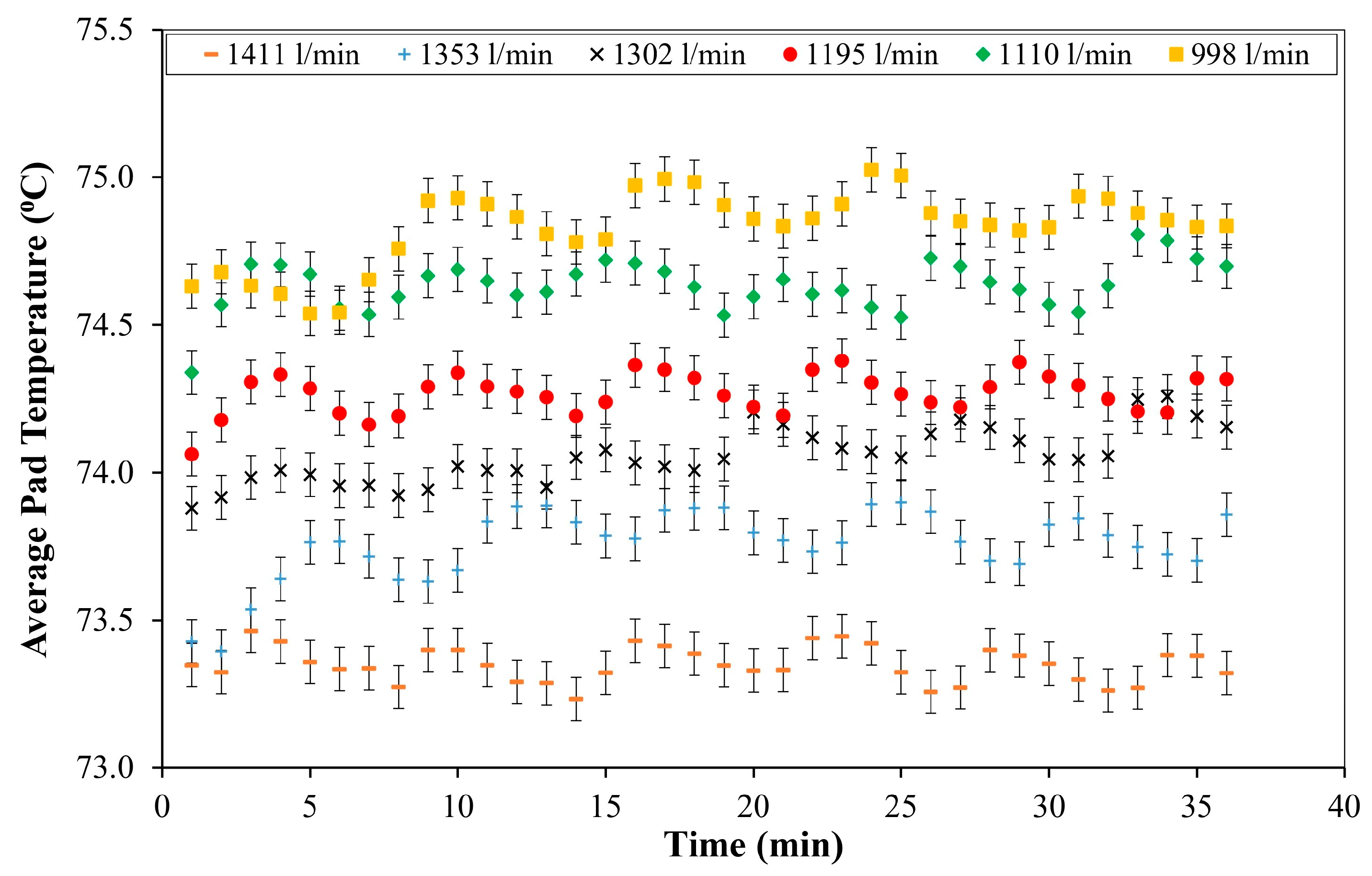
| Sensor Type | Location of the Sensor | Number |
|---|---|---|
| Pressure gauge | Cooling water system-main inlet | 1 |
| Pressure gauge | Generator air cooler-main inlet | 1 |
| Pressure gauge | Generator air cooler-main outlet | 1 |
| Pressure gauge | Cooling water system-thrust bearing main outlet | 1 |
| Temperature sensor | Generator air cooler-main inlet | 1 |
| Temperature sensor | Generator air cooler-main outlet | 1 |
| Temperature sensor | Cooling water system-thrust bearing main outlet | 1 |
| Temperature sensor | Generator air cooler radiators-cooling water outlets | 6 (1 per radiator) |
| Temperature sensor | Generator cooling system radiators-air inlet and outlet | 12 |
| Temperature sensor | New heat exchangers-main oil inlet | 1 |
| Temperature sensor | New heat exchangers-main oil outlet | 1 |
| Temperature sensor | Original heat exchangers-oil inlets | 2 |
| Temperature sensor | Original heat exchangers-oil outlets | 2 |
| Temperature sensor | Thrust bearing pads | 10 (1 per pad) |
| Flowmeter | New cooling system-oil main inlet | 1 |
| Flowmeter | New cooling system-water main inlet | 1 |
| Flowmeter | Original cooling system-water main inlet | 1 |
| No. | Pave (MW) | (L/min) | (L/min) | Toil,in (°C) | Toil,out (°C) | ∆T (°C) | (kW) | Tave,pad (°C) | Tmax,wind (°C) |
|---|---|---|---|---|---|---|---|---|---|
| 1 | 145.9 | 660 | 1110 | 25.5 | 33.5 | 8.1 | 244.5 | 74.8 | 95.3 |
| 2 | 146.1 | 620 | 1110 | 25.7 | 33.7 | 8 | 245.7 | 74.9 | 95.7 |
| 3 | 150.1 | 608 | 1110 | 25.6 | 33.7 | 8.1 | 240.9 | 75.2 | 99.6 |
| 4 | 580 | 1110 | 25.8 | 33.8 | 7.2 | 243.4 | 75.4 | 99.8 | |
| 5 | 580 | 1195 | 25.8 | 32.9 | 7.2 | 238.4 | 75.2 | 100.2 | |
| 6 | 580 | 1411 | 25.6 | 32.1 | 6.3 | 245.5 | 74.6 | 100.2 |
| Name | Pave (MW) | (L/min) | Toil,in (°C) | Toil,out (°C) | ∆T (°C) | (kW) | Tave,pad (°C) | Tmax,wind (°C) |
|---|---|---|---|---|---|---|---|---|
| New | 144 | 660 | 22.6 | 29.1 | 6.5 | 244.5 | 73.4 | 95.2 |
| Orj. | 1317 | 26.5 | 34.0 | 7.5 | 247.5 | 75.1 | 96.5 |
| ω | %ω | ||
|---|---|---|---|
| L/min | kW | kW | % |
| 1411 | 252.6 | ±1.41 | ±0.0056 |
| 1353 | 267.7 | ±1.35 | ±0.0051 |
| 1302 | 275.4 | ±1.30 | ±0.0048 |
| 1195 | 255.1 | ±1.20 | ±0.0047 |
| 1110 | 263.2 | ±1.11 | ±0.0042 |
| 998 | 263.1 | ±1.11 | ±0.0038 |
Disclaimer/Publisher’s Note: The statements, opinions and data contained in all publications are solely those of the individual author(s) and contributor(s) and not of MDPI and/or the editor(s). MDPI and/or the editor(s) disclaim responsibility for any injury to people or property resulting from any ideas, methods, instructions or products referred to in the content. |
© 2025 by the authors. Licensee MDPI, Basel, Switzerland. This article is an open access article distributed under the terms and conditions of the Creative Commons Attribution (CC BY) license (https://creativecommons.org/licenses/by/4.0/).
Share and Cite
Çay, M.S.; Gezer, D. Assessment of an External Cooling System Using Experimental Methods for Thrust Bearing in a Large Hydraulic Unit. Water 2025, 17, 795. https://doi.org/10.3390/w17060795
Çay MS, Gezer D. Assessment of an External Cooling System Using Experimental Methods for Thrust Bearing in a Large Hydraulic Unit. Water. 2025; 17(6):795. https://doi.org/10.3390/w17060795
Chicago/Turabian StyleÇay, Mehmet Sait, and Dogan Gezer. 2025. "Assessment of an External Cooling System Using Experimental Methods for Thrust Bearing in a Large Hydraulic Unit" Water 17, no. 6: 795. https://doi.org/10.3390/w17060795
APA StyleÇay, M. S., & Gezer, D. (2025). Assessment of an External Cooling System Using Experimental Methods for Thrust Bearing in a Large Hydraulic Unit. Water, 17(6), 795. https://doi.org/10.3390/w17060795






